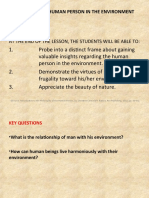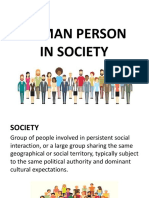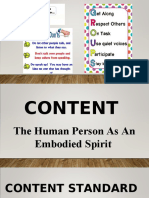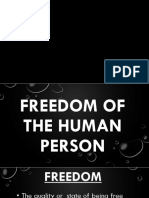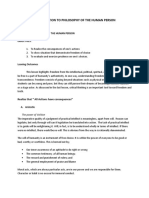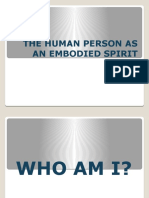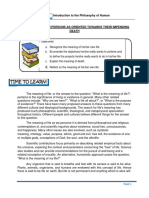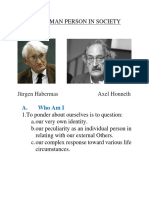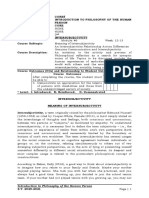100%(7)100% found this document useful (7 votes)
446 viewsIntersubjectivity
Intersubjectivity
Uploaded by
Alisa BosconovitchThe document discusses intersubjective human relations and communicative action. It summarizes Jurgen Habermas's theory of communicative action, which outlines validity claims that must occur in conversation to achieve mutual understanding. These include comprehensibility, truth, truthfulness, and rightness. It also discusses the concepts of subject vs object and intersubjectivity. Martin Buber's "I-Thou" and "I-It" relations are presented, where an "I-Thou" relationship involves mutual and reciprocal connection between subjects, while an "I-It" relationship treats the other as an object. Karol Wojtyla's "we relation" is mentioned as participating to share the humanness of others
Copyright:
© All Rights Reserved
Available Formats
Download as PPTX, PDF, TXT or read online from Scribd
Intersubjectivity
Intersubjectivity
Uploaded by
Alisa Bosconovitch100%(7)100% found this document useful (7 votes)
446 views40 pagesThe document discusses intersubjective human relations and communicative action. It summarizes Jurgen Habermas's theory of communicative action, which outlines validity claims that must occur in conversation to achieve mutual understanding. These include comprehensibility, truth, truthfulness, and rightness. It also discusses the concepts of subject vs object and intersubjectivity. Martin Buber's "I-Thou" and "I-It" relations are presented, where an "I-Thou" relationship involves mutual and reciprocal connection between subjects, while an "I-It" relationship treats the other as an object. Karol Wojtyla's "we relation" is mentioned as participating to share the humanness of others
Original Description:
Intersubjectivity
Copyright
© © All Rights Reserved
Available Formats
PPTX, PDF, TXT or read online from Scribd
Share this document
Did you find this document useful?
Is this content inappropriate?
The document discusses intersubjective human relations and communicative action. It summarizes Jurgen Habermas's theory of communicative action, which outlines validity claims that must occur in conversation to achieve mutual understanding. These include comprehensibility, truth, truthfulness, and rightness. It also discusses the concepts of subject vs object and intersubjectivity. Martin Buber's "I-Thou" and "I-It" relations are presented, where an "I-Thou" relationship involves mutual and reciprocal connection between subjects, while an "I-It" relationship treats the other as an object. Karol Wojtyla's "we relation" is mentioned as participating to share the humanness of others
Copyright:
© All Rights Reserved
Available Formats
Download as PPTX, PDF, TXT or read online from Scribd
Download as pptx, pdf, or txt
100%(7)100% found this document useful (7 votes)
446 views40 pagesIntersubjectivity
Intersubjectivity
Uploaded by
Alisa BosconovitchThe document discusses intersubjective human relations and communicative action. It summarizes Jurgen Habermas's theory of communicative action, which outlines validity claims that must occur in conversation to achieve mutual understanding. These include comprehensibility, truth, truthfulness, and rightness. It also discusses the concepts of subject vs object and intersubjectivity. Martin Buber's "I-Thou" and "I-It" relations are presented, where an "I-Thou" relationship involves mutual and reciprocal connection between subjects, while an "I-It" relationship treats the other as an object. Karol Wojtyla's "we relation" is mentioned as participating to share the humanness of others
Copyright:
© All Rights Reserved
Available Formats
Download as PPTX, PDF, TXT or read online from Scribd
Download as pptx, pdf, or txt
You are on page 1of 40
Content Standard
The learner understands
intersubjective human
relations.
Performance Standard
The learner performs activities that
demonstrate an appreciation for the
talents of persons with disabilities
and those from the underprivileged
sector of the society.
•Income
•Health
•Education
•Empowerment
•Working condition
GUIDE QUESTIONS:
WHAT CAN YOU SAY ABOUT THE
PRESENTED PICTURE?
IS THERE A CONNECTION AMONG THE
PICTURES PRESENTED TO YOU? WHY?
Jurgen Habermas’s Theory Of Communicative Action
Validity claims what must occur in conversation to
achieve mutual understanding
Comprehensibility- the use of ordinary language
Truth- how true uttered statements are, in
reference to objective facts
Truthfulness- genuine intention of the speaker
Rightness- acceptable tone and pitch of voice
Subject vs Object
Intersubjectivity
It is the condition of a man, a
subject, among other man, who are
also subjects.
it refers to shared awareness and
understanding among persons.
It is made possible by the awareness
of the self and the other.
The “I-Thou”
and “I-it”
Relation
-Martin Buber
Martin Buber presented his
philosophy through
a dialogue, a philosophical
theory that showed a
particular quality
interaction, where the
parties involved develop a
connection or relationship.
The “I-Thou”
and “I-it”
Relation
I-it (relationship)
I-it (relationship)
In the “I-It” Relationship
-“I” is the subject and
-“It” is a person treated as an
object
-therefore depicts separateness,
disconnectedness, and detachment
I-Thou (relationship)
I-Thou” Relationship
-“I” is the subject
-“Thou” is another
subject
-it is a relationship of
mutual
and reciprocal
connection
Karol Wojtyla (St. Pope John Paul II)
“we relation”
-We share the humanness of
others through participation.
“ walang sinuman ang namamatay para sa
sarili lamang. Walang sinuman ang
nabubuhay para sa sarili lamang ”
Sense of personhood in our inner self.
Sense of humanness.
Sense of shared being.
Sense of openness
Sense of justice, fairness, empathy, generosity.
Mutual assistance.
Hospitality.
Sensitivity to people’s feelings.
Trust
Sense of gratitude
Thank
You
You might also like
- The Human Person As An Embodied SpiritDocument33 pagesThe Human Person As An Embodied SpiritDaniel Maglalang100% (1)
- Lesson 4 The Human Person in The EnvironmentDocument28 pagesLesson 4 The Human Person in The EnvironmentAaliyah Dueñas Sison80% (10)
- Intro To Philosophy of A Human PersonDocument103 pagesIntro To Philosophy of A Human PersonMo Mutia86% (7)
- The Human Person in SocietyDocument19 pagesThe Human Person in Societymaricar carpio100% (4)
- The Human Person As An Embodied SpiritDocument24 pagesThe Human Person As An Embodied SpiritBek AhNo ratings yet
- The Human Person in SocietyDocument16 pagesThe Human Person in SocietyMichael Quezon100% (7)
- The Human Person As An Embodied SpiritDocument61 pagesThe Human Person As An Embodied SpiritJoan Cabacungan100% (2)
- METHODS OF PHILOSOPHIZING Second SemDocument31 pagesMETHODS OF PHILOSOPHIZING Second SemStephanie Castillon100% (2)
- INTERSUBJECTIVITYDocument34 pagesINTERSUBJECTIVITYPlanning Office100% (1)
- Freedom of The Human PersonDocument56 pagesFreedom of The Human PersonVicmar Villamor50% (2)
- Lesson 6 - IntersubjectivityDocument40 pagesLesson 6 - IntersubjectivityJLenon MendNo ratings yet
- The Human Person As Embodies Spirit 1 1048185Document41 pagesThe Human Person As Embodies Spirit 1 1048185Prancia IlaganNo ratings yet
- Human Person in SocietyDocument13 pagesHuman Person in SocietyJucel Patricia Castrence100% (2)
- L. Human Person in The SocietyDocument37 pagesL. Human Person in The SocietyNOELLE MARIE PAGUNSANNo ratings yet
- The Human Person As An Embodied Spirit - PPT SHOWDocument30 pagesThe Human Person As An Embodied Spirit - PPT SHOWFreda Jeminez50% (2)
- The Human Person in The EnvironmentDocument34 pagesThe Human Person in The EnvironmentChristina Valencia100% (1)
- Freedom of The Human PersonDocument30 pagesFreedom of The Human PersonSharmie Alcantara100% (1)
- The Human As An Embodied SpiritDocument20 pagesThe Human As An Embodied SpiritJoyce Manalo100% (1)
- Lesson 3 - Human Person As An Embodied SpiritDocument41 pagesLesson 3 - Human Person As An Embodied SpiritJennifer Magango89% (9)
- Introduction To The Philosophy of The Human PersonDocument50 pagesIntroduction To The Philosophy of The Human PersonJaneth Miguel Satrain100% (2)
- Human Person in SocietyDocument30 pagesHuman Person in SocietyJillian Dayo100% (5)
- Freedom of The Human PersonDocument42 pagesFreedom of The Human PersonStephanie Castillon100% (2)
- Human Person As An Embodied Spirit 3.3.Document45 pagesHuman Person As An Embodied Spirit 3.3.Lex Henon100% (3)
- Human Person in The Environment FinalDocument18 pagesHuman Person in The Environment FinalTin Tapia100% (1)
- Chapter 2 Methods of PhilosophizingDocument42 pagesChapter 2 Methods of PhilosophizingElvira BondocNo ratings yet
- WEEK 6 - The - Human - Person - As - An - Embodied - SpiritDocument45 pagesWEEK 6 - The - Human - Person - As - An - Embodied - SpiritLeslie Monica MacaisaNo ratings yet
- Freedom of The Human PersonDocument21 pagesFreedom of The Human Persongladys ambitoNo ratings yet
- Freedom As Human Person (1) JVDXBFBJVXKJBDFXVJBJKBXDocument6 pagesFreedom As Human Person (1) JVDXBFBJVXKJBDFXVJBJKBXAnonymous Xo34sx100% (29)
- The Human Person As An Embodied SpiritDocument18 pagesThe Human Person As An Embodied SpiritGene Leonard FloresNo ratings yet
- Week H - Embodied Spirit3Document4 pagesWeek H - Embodied Spirit3JonalynNo ratings yet
- Human Person As A Embodied SpiritDocument23 pagesHuman Person As A Embodied SpiritAlfrancis franciaNo ratings yet
- The Human Person As An Embodied SpiritDocument99 pagesThe Human Person As An Embodied SpiritBoruto Jr CondeNo ratings yet
- Freedom of The Human PersonDocument12 pagesFreedom of The Human PersonJuvee AysonNo ratings yet
- Lesson 4 - Human Person in The EnvironmentDocument32 pagesLesson 4 - Human Person in The EnvironmentKotch LupasiNo ratings yet
- Freedom of The Human PersonDocument49 pagesFreedom of The Human PersonAlyssa LoisNo ratings yet
- Human Persons As Oriented Towards Their Impending DeathDocument29 pagesHuman Persons As Oriented Towards Their Impending DeathAngel Cascayan Delos SantosNo ratings yet
- Human Persons As Oriented Towards Their Impending DeathDocument6 pagesHuman Persons As Oriented Towards Their Impending DeathFrancia Lat-iw Diwas50% (2)
- LP in Intro To Philo Continuation Week 1Document5 pagesLP in Intro To Philo Continuation Week 1raffy noblezaNo ratings yet
- The Human Person in SocietyDocument4 pagesThe Human Person in SocietyJanelle MingmingNo ratings yet
- Lesson 1 Intro To Philosophy - Holistic Perspective Vs Partial Point of ViewDocument36 pagesLesson 1 Intro To Philosophy - Holistic Perspective Vs Partial Point of ViewJake Anthony MajadillasNo ratings yet
- The Human Person in SocietyDocument23 pagesThe Human Person in SocietyJohnrey DureroNo ratings yet
- Human Person As An Embodied SpiritDocument2 pagesHuman Person As An Embodied SpiritCarl Justine A. Ofiaza100% (1)
- IntersubjectivityDocument6 pagesIntersubjectivityClarizzaPaz100% (1)
- Inter SubjectivityDocument58 pagesInter SubjectivityAllan Jr Anore100% (1)
- Lesson 4 The Human Person in The EnvironmentDocument26 pagesLesson 4 The Human Person in The EnvironmentJohn De Asis100% (1)
- 6 IntersubjectivityDocument14 pages6 IntersubjectivityBianca YamuganNo ratings yet
- Chapter 13 - Human Person As Oriented Towards Their Impending DeathDocument9 pagesChapter 13 - Human Person As Oriented Towards Their Impending DeathHarry Potter100% (2)
- Q2 Week C - IntersubjectivityDocument18 pagesQ2 Week C - IntersubjectivityLiza Buemio86% (7)
- Chapter 7 The Human Person in SocietyDocument6 pagesChapter 7 The Human Person in Societysheisbonjing PH50% (4)
- Intersubjectivity: Objective Subjective Object Subject Subject Subjective ObjectiveDocument1 pageIntersubjectivity: Objective Subjective Object Subject Subject Subjective ObjectiveHannah Beatriz QuiambaoNo ratings yet
- Lesson3 Thehumanasanembodiedspirit 180717110754Document24 pagesLesson3 Thehumanasanembodiedspirit 180717110754Arianne Dela Rosa PerezNo ratings yet
- Human Person As An Embodied SpiritDocument19 pagesHuman Person As An Embodied SpiritJay-R De Guzman100% (1)
- Week I - The Human Person in Their EnvironmentDocument5 pagesWeek I - The Human Person in Their EnvironmentClaire E JoeNo ratings yet
- Human Persons As Oriented Towards Their Implementing DeathDocument17 pagesHuman Persons As Oriented Towards Their Implementing DeathKristine Requiron TusanNo ratings yet
- Introduction To The Philosophy of The Human PersonDocument25 pagesIntroduction To The Philosophy of The Human PersonCristopherPagdanganan100% (1)
- Philosophy Lesson 3: The Human Body As An Embodied SpiritDocument27 pagesPhilosophy Lesson 3: The Human Body As An Embodied SpiritLeigh M50% (2)
- Introduction To Philosophy of The Human PersonDocument8 pagesIntroduction To Philosophy of The Human PersonBEJERAS GrantNo ratings yet
- Intersubjectivity 1Document4 pagesIntersubjectivity 1School Desk SpaceNo ratings yet
- The Human Person and Intersubjective Human RelationDocument17 pagesThe Human Person and Intersubjective Human RelationAndrea Gienel MontallanaNo ratings yet
- Local Media7206356050706637850Document99 pagesLocal Media7206356050706637850Ry WannaFlyNo ratings yet

